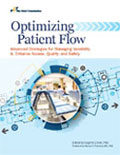Optimizing Patient Flow Advanced Strategies for Managing Variability to Enhance Access, Quality, and Safety

Author: Eugene Litvak, PhD
Affiliation:
Publisher: Joint Commission Resources
Publication Date: 2018
ISBN 10: 1635850398
ISBN 13: 9781635850390
eISBN: 9781635850406
Edition: 1st
Affiliation:
Publisher: Joint Commission Resources
Publication Date: 2018
ISBN 10: 1635850398
ISBN 13: 9781635850390
eISBN: 9781635850406
Edition: 1st
Description:
Edited by Eugene Litvak, Ph.D., a world-renowned leader in hospital operations management and redesign Foreword by Dr. Harvey Fineberg, president of the Gordon and Betty Moore Foundation and former president of the Institute of Medicine Optimizing patient flow impacts patient safety and the quality of care, and it has financial implications for health care institutions. Yet the story hasn't changed much in the decades that patient flow has been a focus of health care administrators. Hospitals are straining to meet demand. Surgeries continue to be delayed. Ambulances are diverted. Emergency departments are overcrowded while waiting for inpatient beds. Staffing shortages and economic challenges only serve to exacerbate the inefficiencies of patient flow. Perhaps this approach to managing patient flow is not the best one. Crowded emergency departments and empty operating rooms are indicative of the variability in patient flow throughout the hospital, including emergency rooms and ICUs, as well as the flow to other settings of care, such as home care. Our second title edited by patient flow expert Dr. Eugene Litvak, Optimizing Patient Flow: Advanced Strategies for Managing Variability to Enhance Access, Quality, and Safety, offers readers innovative techniques for optimizing patient flow and improving operations management while providing clear examples of successful implementation. It can help you optimize patient flow in your own organization. This book goes beyond the introductory information provided in JCR's popular Managing Patient Flow in Hospitals: Strategies and Solutions, Second Edition. Dr. Litvak has teamed with CEOs, doctors, and researchers who have compiled their own experiences with patient flow to produce a book that guides the reader to practical and achievable advances in patient flow by sharing stories of how it was attained in actual health care organizations and providing specific approaches to reducing and managin
Related Titles
